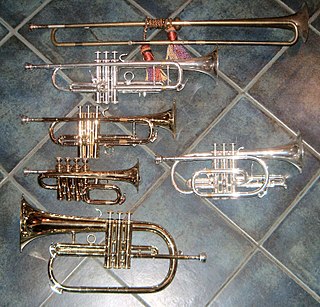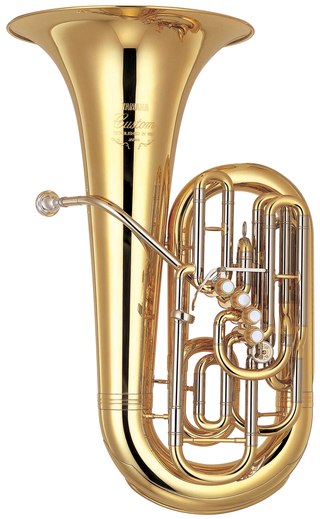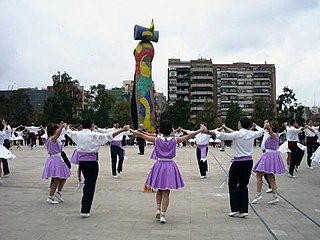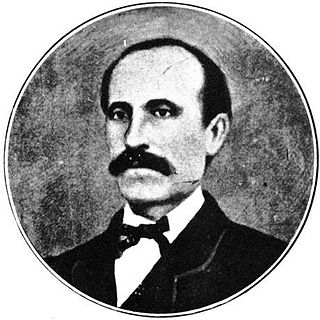
A brass instrument is a musical instrument that produces sound by sympathetic vibration of air in a tubular resonator in sympathy with the vibration of the player's lips. The term labrosone, from Latin elements meaning "lip" and "sound", is also used for the group, since instruments employing this "lip reed" method of sound production can be made from other materials like wood or animal horn, particularly early or traditional instruments such as the cornett, alphorn or shofar.

The euphonium is a medium-sized, 3- or 4-valve, often compensating, conical-bore, tenor-voiced brass instrument that derives its name from the Ancient Greek word εὔφωνος euphōnos, meaning "well-sounding" or "sweet-voiced". The euphonium is a valved instrument. Nearly all current models have piston valves, though some models with rotary valves do exist.

The flugelhorn, also spelled fluegelhorn, flugel horn, or flügelhorn, is a brass instrument that resembles the trumpet and cornet, but has a wider, more conical bore. Like trumpets and cornets, most flugelhorns are pitched in B♭, though some are in C. It is a type of valved bugle, developed in Germany in the early 19th century from a traditional English valveless bugle. The first version of a valved bugle was sold by Heinrich Stölzel in Berlin in 1828. The valved bugle provided Adolphe Sax with the inspiration for his B♭ soprano (contralto) saxhorns, on which the modern-day flugelhorn is modelled.

The saxhorn is a family of valved brass instruments that have conical bores and deep cup-shaped mouthpieces. The saxhorn family was developed by Adolphe Sax, who is also known for creating the saxophone family. The sound of the saxhorn has a characteristic mellow tone quality and blends well with other brass.

The trombone is a musical instrument in the brass family. As with all brass instruments, sound is produced when the player's vibrating lips cause the air column inside the instrument to vibrate. Nearly all trombones use a telescoping slide mechanism to alter the pitch instead of the valves used by other brass instruments. The valve trombone is an exception, using three valves similar to those on a trumpet, and the superbone has valves and a slide.

The trumpet is a brass instrument commonly used in classical and jazz ensembles. The trumpet group ranges from the piccolo trumpet—with the highest register in the brass family—to the bass trumpet, pitched one octave below the standard B♭ or C trumpet.

The tuba is the largest and lowest-pitched musical instrument in the brass family. As with all brass instruments, the sound is produced by lip vibration – a buzz – into a mouthpiece. It first appeared in the mid-19th century, making it one of the newer instruments in the modern orchestra and concert band, and largely replaced the ophicleide. Tuba is Latin for "trumpet".

The baritone horn, sometimes called baritone, is a low-pitched brass instrument in the saxhorn family. It is a piston-valve brass instrument with a bore that is mostly conical, like the smaller and higher pitched flugelhorn and tenor horn, but it has a narrower bore compared to the similarly pitched euphonium. It uses a wide-rimmed cup mouthpiece like that of its peers, the trombone and euphonium. Like the trombone and the euphonium, the baritone horn can be considered either a transposing or non-transposing instrument.

The music of Catalonia comprises one of the oldest documented musical traditions in Europe. In tandem with the rest of Western Europe, it has a long musical tradition, incorporating a number of different styles and genres over the past two thousand years.

The sardana is a Catalan musical genre typical of Catalan culture and danced in circle following a set of steps. The dance was originally from the Empordà region, but started gaining popularity throughout Catalonia from the late 19th century to beginning of the 20th century after the modernisation done by Josep Maria Ventura i Casas.

The flabiol is a Catalan woodwind musical instrument of the family known as fipple flutes. It is one of the 12 instruments of the cobla. The flabiol measures about 25 centimeters in length and has five or six holes on its front face and three underneath.

Marching brass instruments are brass instruments specially designed to be played while the player is moving. Not all instruments have a corresponding marching version, but many do, including the following:

The cobla is a traditional music ensemble of Catalonia, and in Northern Catalonia in France. It is generally used to accompany the sardana, a traditional Catalan folk dance, danced in a circle.

In music, a Catalan shawm is one of two varieties of shawm, an oboe-like woodwind musical instrument played in Catalonia in northeastern Spain.

The tambori is a percussion instrument of about 10 centimetres diameter, a small shallow cylinder formed of metal or wood with a drumhead of skin. Its usual function is to accompany the playing of the flabiol in a cobla band, beating the rhythm of the sardana, the traditional dance of Catalonia.

The xeremia is a type of bagpipe native to the island of Majorca (Mallorca). It consists of a bag made of skin, known as a sac or sarró which retains the air, a blowpipe (bufador), a melody pipe or chanter (grall), and several, generally three, drones (bordons). The primary drone (roncó) sounds a tonic note, but the other drones are sometimes simply false drones for ornamentation.

The saxotromba is a valved brass instrument invented by the Belgian instrument-maker Adolphe Sax around 1844. It was designed for the mounted bands of the French military, probably as a substitute for the French horn. The saxotrombas comprised a family of half-tube instruments of different pitches. By about 1867 the saxotromba was no longer being used by the French military, but specimens of various sizes continued to be manufactured until the early decades of the twentieth century, during which time the instrument made sporadic appearances in the opera house, both in the pit and on stage. The instrument is often confused with the closely related saxhorn.

Josep Maria Ventura i Casas, popularly known as Pep Ventura, was a Spanish musician and composer from Catalonia who consolidated the long sardana and reformed the cobla, adding instruments to give it its current formation.
Companyia Elèctrica Dharma is a Catalan band. Many of its members are brothers, from the district of Sants, in the city of Barcelona. They have performed in Europe, North and South America, and Africa at music festivals such as "Rock in Rio", Rio de Janeiro (Brasil) "Memphis In May" Memphis (USA) "Festival of Essakane" (Mali) "Awesome Africa Festival" and Durban. Their albums are sold all over the world. The band's music is a fusion of Cobla, Rock, Jazz, Blues, Progressive music, and Symphonic rock.
Vicenç Bou i Geli was a Catalan Spanish composer. He was most well known for his compositions of the traditional sardanes, which he wrote with great fluency and little sophistication, but with a gift for charming and ingenious melody.



















